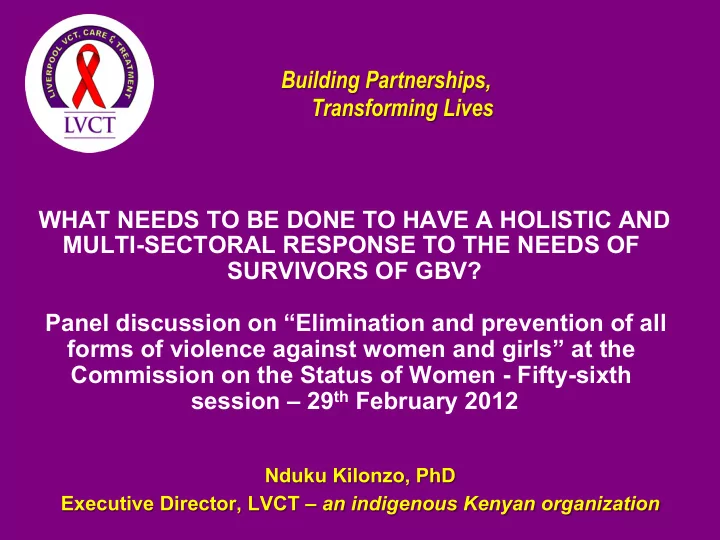

Building Partnerships, Transforming Lives WHAT NEEDS TO BE DONE TO HAVE A HOLISTIC AND MULTI-SECTORAL RESPONSE TO THE NEEDS OF SURVIVORS OF GBV? Panel discussion on “Elimination and prevention of all forms of violence against women and girls” at the Commission on the Status of Women - Fifty-sixth session – 29 th February 2012 Nduku Kilonzo, PhD Executive Director, LVCT – an indigenous Kenyan organization
Situating current responses l Data on VAW and its impact on health, productivity, economy are well known l Services are few – Limited in scope, range and quality – Most models – NGO projects – Few models provide the ‘how to’ of developing cross-sector services or of bringing to scale So, what is needed? - this presentation – Focus on gaps and challenges – Focus on national systems - the primary foundation for sustained scale up of services l 2
The context? l VAW – different manifestations, severity and chronicity by different women – Need for different types of services – State responsibility to avail these services – States have abdicated this responsibility l Different forms of GBV inter-connected, – Survivors tend to experience multiple forms of GBV – Current services and legislation focus on SV – Responding to only one form of SV will not respond to the needs of women The false dichotomy created between different forms of GBV will compromise development of holistic services and the response to needs of survivors 3
Gaps and challenges? 4
Responsibility and accountability? l Lack of responsibility, accountability and strong leadership – No institutional home for GBV – Ministry specific mandate (health, law/order/justice, social services) is not cross-sectoral – No joint planning at government level l Multiple, diverse and un-coordinated stakeholders – Multiple private and civil society organizations (prevention, care treatment; service delivery, capacity-building and advocacy; legal, health, social services; policy, research, programming) – Stakeholders in competition – Parallel and uncoordinated funding and efforts by DPs reduce opportunities for leveraging on resources, technical and human capacities 5
Service delivery approaches? l Is it, ‘either/or’ for different approaches? Or is it a the most suitable combination? – ‘one-stop’ vs ‘integrated’ models or both for different settings? – Consideration for models that are compatible with all sectors One-stop services : Feasible for high population, high density, high resource programmes BUT challenging for scale up in limited resources setting, rural set-ups Integrated services: Allow for scale up as part of integrated health care systems (personnel, commodities, drugs, follow up) and can be brought to national scale with accountability indicators l Purposes of the different models – Funding agency preferences? Or in-country needs, resources and ability to sustain post external financing? 6
Scale up and standards? l Defining scale up of VAW – Different VAW manifestations require different service packages and targets e.g. Chronic SV in the homestead cannot be treated the same as a SV event; Severe IPV requires different services – GBV programme outcomes are not agreed on – There exist no coverage indicators across different sectors l Joint planning (sectors/stakeholders)-currently challenging l Lack of policy guidelines and standards – Some sector guidance available in some countries – No cross-sector guidance for evidence and for survivor management across sectors 7
Local realities? Limited cognizance of local realities in service devt’ as primary to sustained service delivery l Legislation/services rely on forensic evidence - possible? – e.g. FORENSICS - DNA infrastructure, functional evidence chain, criminal data bank, follow-up mechanisms – Proper documentation more likely to result in justice vs forensic evidence – Jewkes et al, 2009 l Commodities and supplies at desired service points? – Drugs e.g EC, PEP; secure crime scene investigation tools, data tools at point of care – Consideration for: costs of addition into supply management chain, potential for stockouts when developing service models l Limited funding investment into availability of supplies 8
Providers? l Standards for building human resource capacities – No national training curricular – No cross-sectoral training requirements – Training fragmented and focused on in-service (expensive, does not institutionalize GBV knowledge and skills, not sustainable) Measuring success? l No common indicators that are sector specific, and that are cross sectoral – Lack of data collection tools, mechanisms and responsibility – Data collation to national level reporting is lacking as there is no responsibility – Data for medical/legal purposes not highly valued l 9
Recommendations l Well resourced institutional homes with RESPONSIBILITY, AUTHORITY and ACCOUNTABILITY for GBV – Stakeholder coordination – Harmonized service delivery – National reporting framework l In-country coordination mechanisms urgently needed – Stakeholder coordination meetings – Joint planning – Information exchange and sharing l Common consensus on outcomes, coverage for different service packages and multi-sectoral indicators 10
Building Partnerships, Transforming Lives nkilonzo@lvct.org enquiries@lvct.org www.liverpoolvct.org one2onekenya.org 11
Recommend
More recommend